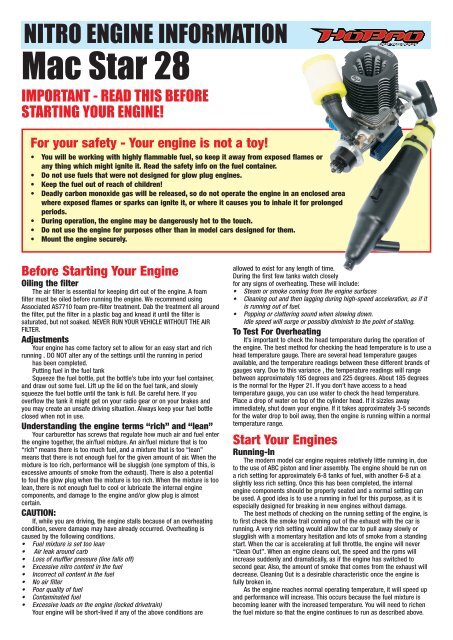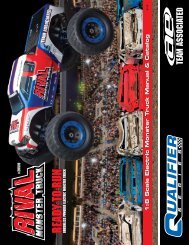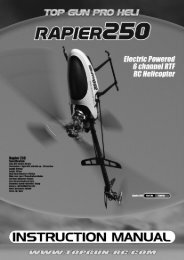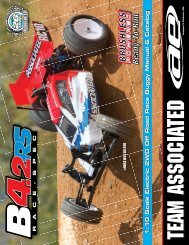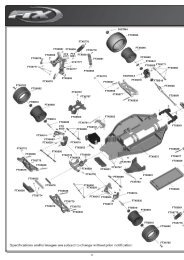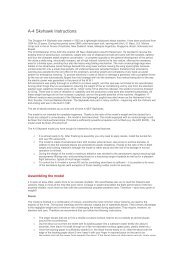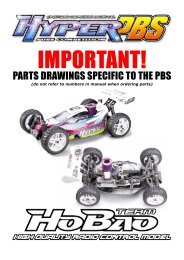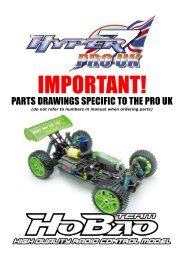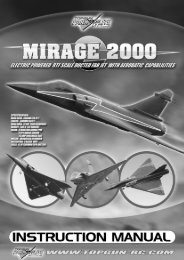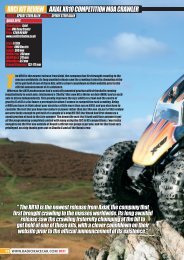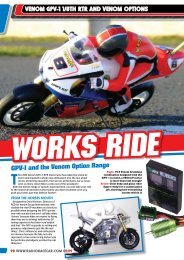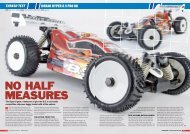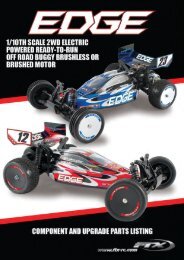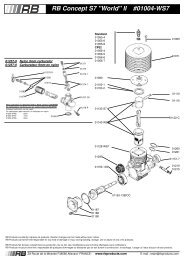HoBao Mac Star 28 Engine Information - CML Distribution
HoBao Mac Star 28 Engine Information - CML Distribution
HoBao Mac Star 28 Engine Information - CML Distribution
- No tags were found...
You also want an ePaper? Increase the reach of your titles
YUMPU automatically turns print PDFs into web optimized ePapers that Google loves.
NITRO ENGINE INFORMATION<strong>Mac</strong> <strong>Star</strong> <strong>28</strong>IMPORTANT - READ THIS BEFORESTARTING YOUR ENGINE!For your safety - Your engine is not a toy!• You will be working with highly flammable fuel, so keep it away from exposed flames orany thing which might ignite it. Read the safety info on the fuel container.• Do not use fuels that were not designed for glow plug engines.• Keep the fuel out of reach of children!• Deadly carbon monoxide gas will be released, so do not operate the engine in an enclosed areawhere exposed flames or sparks can ignite it, or where it causes you to inhale it for prolongedperiods.• During operation, the engine may be dangerously hot to the touch.• Do not use the engine for purposes other than in model cars designed for them.• Mount the engine securely.Before <strong>Star</strong>ting Your <strong>Engine</strong>Oiling the filterThe air filter is essential for keeping dirt out of the engine. A foamfilter must be oiled before running the engine. We recommend usingAssociated AS7710 foam pre-filter treatment. Dab the treatment all aroundthe filter, put the filter in a plastic bag and knead it until the filter issaturated, but not soaked. NEVER RUN YOUR VEHICLE WITHOUT THE AIRFILTER.AdjustmentsYour engine has come factory set to allow for an easy start and richrunning . DO NOT alter any of the settings until the running in periodhas been completed.Putting fuel in the fuel tankSqueeze the fuel bottle, put the bottle’s tube into your fuel container,and draw out some fuel. Lift up the lid on the fuel tank, and slowlysqueeze the fuel bottle until the tank is full. Be careful here. If youoverflow the tank it might get on your radio gear or on your brakes andyou may create an unsafe driving situation. Always keep your fuel bottleclosed when not in use.Understanding the engine terms “rich” and “lean”Your carburettor has screws that regulate how much air and fuel enterthe engine together, the air/fuel mixture. An air/fuel mixture that is too“rich” means there is too much fuel, and a mixture that is too “lean”means that there is not enough fuel for the given amount of air. When themixture is too rich, performance will be sluggish (one symptom of this, isexcessive amounts of smoke from the exhaust). There is also a potentialto foul the glow plug when the mixture is too rich. When the mixture is toolean, there is not enough fuel to cool or lubricate the internal enginecomponents, and damage to the engine and/or glow plug is almostcertain.CAUTION:If, while you are driving, the engine stalls because of an overheatingcondition, severe damage may have already occurred. Overheating iscaused by the following conditions.• Fuel mixture is set too lean• Air leak around carb• Loss of muffler pressure (line falls off)• Excessive nitro content in the fuel• Incorrect oil content in the fuel• No air filter• Poor quality of fuel• Contaminated fuel• Excessive loads on the engine (locked drivetrain)Your engine will be short-lived if any of the above conditions areallowed to exist for any length of time.During the first few tanks watch closelyfor any signs of overheating. These will include:• Steam or smoke coming from the engine surfaces• Cleaning out and then lagging during high-speed acceleration, as if itis running out of fuel.• Popping or clattering sound when slowing down.Idle speed will surge or possibly diminish to the point of stalling.To Test For OverheatingIt’s important to check the head temperature during the operation ofthe engine. The best method for checking the head temperature is to use ahead temperature gauge. There are several head temperature gaugesavailable, and the temperature readings between these different brands ofgauges vary. Due to this variance , the temperature readings will rangebetween approximately 185 degrees and 225 degrees. About 185 degreesis the normal for the Hyper 21. If you don’t have access to a headtemperature gauge, you can use water to check the head temperature.Place a drop of water on top of the cylinder head. If it sizzles awayimmediately, shut down your engine. If it takes approximately 3-5 secondsfor the water drop to boil away, then the engine is running within a normaltemperature range.<strong>Star</strong>t Your <strong>Engine</strong>sRunning-InThe modern model car engine requires relatively little running in, dueto the use of ABC piston and liner assembly. The engine should be run ona rich setting for approximately 6-8 tanks of fuel, with another 6-8 at aslightly less rich setting. Once this has been completed, the internalengine components should be properly seated and a normal setting canbe used. A good idea is to use a running in fuel for this purpose, as it isespecially designed for breaking in new engines without damage.The best methods of checking on the running setting of the engine, isto first check the smoke trail coming out of the exhaust with the car isrunning. A very rich setting would allow the car to pull away slowly orslugglish with a momentary hesitation and lots of smoke from a standingstart. When the car is accelerating at full throttle, the engine will never“Clean Out”. When an engine cleans out, the speed and the rpms willincrease suddenly and dramatically, as if the engine has switched tosecond gear. Also, the amount of smoke that comes from the exhaust willdecrease. Cleaning Out is a desirable characteristic once the engine isfully broken in.As the engine reaches normal operating temperature, it will speed upand performance will increase. This occurs because the fuel mixture isbecoming leaner with the increased temperature. You will need to richenthe fuel mixture so that the engine continues to run as described above.
When the first tank is almost gone, bring the car in and shut off theengine. Allow the engine to cool for 8 to 10 minutes before starting theengine up again. Add more fuel. <strong>Star</strong>t it back up and run the second tankof fuel. Again allow the engine to cool before starting it up again.The key to breaking in your engine is patience. During the break inperiod , your engine may appear to malfunction with problems such asstalling, inconsistent performance, and fouling out glow plugs. Don’t giveup. These are just a few things you may go through during the break inperiod. Just keep it running, apply the throttle on and off as smoothly asyou can. Sudden bursts or quick releases of the throttle can stall yourengine. Soon after break in your patience will pay off with a well runningengine. The performance level of theengine will be limited by the “rich’ fuel mixture which you will use allduring the break-in process. Once the engine is fully broken-in the mixturecan be “leaned out,” and speed and acceleration will increase. Because ofthe rich fuel mixture and the wearing of the new parts, deposits will formon the glow plug causing it to fail. Expect to replace the glow plug duringthe break in period, and definitely when the engine is fully broken in andthe fuel mixture is leaned out.Setting <strong>Engine</strong> for NormalTuning High SpeedAs you approach the first 6-8 tanks running you can start toGRADUALLY adjust you engine for normal performance. PLEASE NOTE anyadjustments need to be very small at 1/8th turn increments. You can thenbegin adjusting the fuel mixture to maximize performance for your drivingneeds. To lean turn the main fuel control needle in a clockwise direction.This will allow the car to pull away faster and more cleanly, withouthesitation and increase the top speed. There should however still be anoticeable smoke trail.If the main needle is screwed in too far thus allowing the engine torun too lean, it will seem to run strong at first, but will bog, hesitate,or stall when running at high speed. The engine will also rapidlyoverheat when the setting is too lean. This is because fuel includeslubrication, and that lubrication is inadequate when the setting is too lean.CHECK THE ENGINE TEMPERATURE OFTEN AS YOU LEAN THE MIXTURE. DONOT LET THE ENGINE OVERHEAT. You should always see smoke comingfrom the exhaust.At the optimum setting, the engine will clean out; have a strongsounding,high-pitched whine at full speed; and there will be a thin trail ofwhitish smoke coming from the exhaust. It is always better to set theengine a little rich rather than too lean.If the engine stalls on acceleration, begins to bog or slow down at fullthrottle, or if there is a reduction in exhaust smoke, then the engine isrunning too lean. Immediately turn the high speed mixture screwcounterclockwise 1/4 of a turn and operate the car at medium speeds for1 to 2 minutes to allow the engine to cool.Tuning Low SpeedThe low-speed mixture affects how the engine will perform in the lowto mid range rpms. Turning the low-speed needle clockwise will lean themixture. As with the high-speedmixture, leaning the low-speedmixture increases performance.Again, if the mixture here is set toolean, the engine may be starved forlubrication in the lowand mid-rpmranges, thus causing overheatingand excessive engine wear.Perform the following test todetermine if the low speed mixtureis set correctly. With the enginewarm and running, allow it to idlefor approximately 15 seconds. Nowquickly apply throttle and note the performance. If the engine bogs,accelerates erratically, and a large puff of blue smokes emitted, then thelow speed mixture is too rich. Turnthe low-speed screw clockwise 1/8of a turn. If the engine speeds upfor a moment then bogs, hesitates,or stalls, then the low speedmixture is too lean. Turn the screwcounterclockwise 1/8 of a turn.Adjust the mixture screws in 1/8 ofa turn increments, wait 15seconds, and retest after eachchange. Adjust for the bestacceleration without the carstalling.IDLEADJUSTMENTLOW SPEEDADJUSTMENTHIGH SPEEDADJUSTMENTCare and MaintenanceWhen you are finished racing for the day, drain the fuel tank.Afterwards, energize the glow plug with your glow plug starter and try torestart the engine in order to burn off any fuel that may remain inside theengine. Repeat this procedure until the engine fails to fire. Try to ejectresidue while the engine is still warm. Finally, inject some corrosioninhibiting oil, and rotate the engine to distribute the oil to all the workingparts. Do not, however, inject the oil into the carburetor, for it may causethe O-rings inside to deteriorate. When cleaning the exterior of the engine,use WD-40. Do not use gasoline or any solvents that might damage thesilicone fuel tubing.Cleaning the air filter. When the air filter starts to get dirty, do thefollowing steps:Step 1. Clean the foam with fuel. Do this by pouring a little fuel in a smallcan and kneading the filter in the fuel. When it looks cleaner, thendispose of the fuel.Step 2. Dry the filter. Squeeze out the fuel with a paper towel until it’s dry.Step 3. Apply Associated’s #7710 Foam Pre-Filter Treatment to help keepthe dirt out. Dab the treatment all around the filter, put the filter ina plastic sandwich bag, and knead it until the filter is saturated,but not soaked.TroubleshootingGlow Plug ProblemsThe glow plug in your engine is an inexpensive consumable itemwhich must be replaced periodically to maintain peak performance andstarting ease. Most often, any starting problems or erratic performancecan be traced back to the glow plug. The glow plug should also bechecked if the engine’s acceleration and top speed performance suddenlybecomes flat. The only sure way to test for a faulty glow plug is simplyinstall a new one to see if the problem goes away. Remove the plug fromthe cylinder head with a 5/16” nut driver. Make sure there is no dirt ordebris on top of the head which could fall into the engine. Do not loose thecopper gasket which seals the glow plug. Touch the glow plug to thecontacts of the glow plug starter. All of the coils should glow white.Sometimes the first few coils will not glow while the rest are bright, mostlikely indicating a bad plug. If the glow is dim orange, then the glowstarter battery should be replaced or recharged.At the high rpm that the engines operate only a top quality plug willcut the mustard. Therefore we recommend the use of either McCoy MC9or RB #6 plugs.Fuel MixtureThe fuel mixture is the largest variable you have to control whileoperating your engine.Fuel brand, ambient temperature, and humidity all effect how yourmixture should be set. If the engine runs great one day but runs rich orlean the next day, it is probably the result of a change in the air qualityand temperature. This should be expected and adjusted for.Although there are many fuels on the market, very few are designedto perform and protect your engine at the likes of 35,000rpm that some ofour engines can attain. It is with this fact in mind, and our own in housetesting that we ONLY RECOMMEND the following fuels:Byron RACE Gen2, Byron RACE Gen2RTR and Model Technics Dynaglow.Keep between 10 and 20% nitromethenecontent for running and first use. The singlemost popular reason for engine failure orunreliability is poor or wrong fuel. Thesefuels have been tested with our enginesand we are confident of theirperformance.OTHER FUELS MAY WORKWITH OTHER ENGINES BUTTHE FUELS LISTED WORKBEST WITH THESE ENGINES.FAILURE TO KEEP TO THESEFUELS MAY RESULT INDAMAGE OR REDUCEDPERFORMANCE AND VOIDANY WARRANTY CLAIMS.
Pull <strong>Star</strong>ter HintsThe pull starter as fitted to most of the entry level engines is, iftreated correctly, the easiest and most cost effective method of starting anengine. As with every silver lining, there is a cloud. The pullstart system issimilar to that of a lawnmower to look at, but that is where the similarityends. The pullstarter is susceptible to breaking if the engine is flooded ornot lubricated enough. To ensure this does not happen, a few simple rulesshould be followed.1. Before attempting to start the engine from cold, remove theglowplug and then prime the engine with fuel. For cars with a primerbuttonon the tank, press this until the fuel has travelled along the fuel pipeto the carburettor and then a further 10-20 presses. For cars without aprimer on the tank, pull the pullstarter rapidly with your finger over theexhaust pipe outlet until the fuel has travelled to the carb, and then afurther 10-20 times to lube the engine.2. Then turn the car upside down and pull the pullstarter rapidly untilall the excess fuel has emptied onto the floor through the glowplug hole.Refit the plug ensuring the copper gasket washer is also refitted. Wind itall the way in and then re-wind 1 to 1.5 turns. This allows gases to escapethus lowering the engines initial compression.3. <strong>Star</strong>t engine. The engine will run “lumpily” or stop after a fewseconds so try and keep it running by blipping the throttle. Tighten theglowplug while the engine is running if possible. If the engine has stalledrestart with the plug tightened.The above procedure hould always be followed from cold or ifdifficulty with starting is being experienced.Troubleshooting Quick GlanceDescriptionProblemFlooding of the <strong>Engine</strong>The most common cause of engine and pullstarter damage is from the‘flooding” of the engine or a hydro-locked. More accurately this is toomuch fuel inside the engines crankcase causing the piston to lock. Thepiston rises to the top of the combustion chamber and instead ofcompressing a gas i.e. fuel/air mixture it has to try and compress a liquid,fuel only, which isn’t possible. This puts massive strain on the piston,conrod and crankshaft as well as the starter. Invariably one componentwill fail, usually the conrod causing massive damage to the enginesinternals.To avoid flooding the engine, always start the engine from cold usingthe methods mentioned above and if at any time the engine becomesdifficult to turn over with the pullstarter, then remove the glowplug andempty all excess fuel out and start again. The pullstarter assembly canonly be damaged by a flooded engine, so if you break a pullstarter, this isa warning that your are flooding the engine.Cooling Problems<strong>Engine</strong> overheating is most often caused by running the engine toolean or because the cooling air for the cylinder head is blocked. If themixture is too lean, simply allow the engine to cool, richen the mixture andtry it again. Bodies must have holes cut in them to allow for cooling air tocirculate over the surface of the cylinder head. On most bodies, it is agood idea to cut part of the wind-shield out and part of the back windowto allow for additional cooling.Soloution<strong>Engine</strong> will not start<strong>Star</strong>ter will not pull<strong>Engine</strong> starts andthen stalls<strong>Engine</strong> sluggish /poor performance<strong>Engine</strong> overheats<strong>Engine</strong> hesitates orstumbles<strong>Engine</strong> stalls instantlywhen throttle is fullyopened from idle<strong>Engine</strong> stalls whiledriving around turnsOut of fuelImproper or contaminated fuelGlow starter not chargedGlow plug bad<strong>Engine</strong> flooded<strong>Engine</strong> overheatingCarburetor incorrectly adjustedExhaust blockedAir cleaner blocked<strong>Engine</strong> is floodedRope is jammed<strong>Engine</strong> seizedIdle speed set too lowAir bubbles in fuel lineGlow plug is fouled<strong>Engine</strong> is overheatedInsufficient fuel tank pressureBlockage at exhaust header fittingHigh-speed fuel mixture is too richLeaking glow plugFuel bad or contaminatedCarburetor dirty or blocked<strong>Engine</strong> overheating<strong>Engine</strong> over geared for applicationClutch slippingBound up drive trainHigh-speed fuel mixture is too leanCooling air is being blockedExcessive nitro in the fuelExcessive load on the engineLow-speed mixture too leanHigh-speed mixture too leanLow-speed mixture too rich<strong>Engine</strong> overheatedAir bubbles in fuel lineGlow plug fouledGlow plug fouledLow-speed mixture too leanHigh-speed mixture too richFuel level is lowIdle speed set too lowFill fuel tankReplace fuelCharge glow starterReplace glow plug, see “Glow Plug Problems”See “ flooding” section.Allow engine to cool, richen fuel mixture, check airflowReadjust carburetorClean exhaust systemClean air filterClear excess fuel, see “flooding” Section.Repair starter.Examine engine for damage.Increase idle speed.Check for holes in the fuel line.Replace glow plug, see “Glow Plug Problem” section.Allow engine to cool, richen fuel Mixture, check airflowReplace pressure hose- clearCheck flow to and from the tank.Set high-speed mixture to a leaner settingCheck glow plug gasketReplace fuelClean CarburetorStop the engine- find the causeUse a lower gear ratioReplace clutch shoesFind the bound item and repairRichen high-speed mixtureGet air to the headUse fuel with lower nitroCheck for bound up drive trainRichen low-speed mixtureRichen high-speed mixture.Lean low-speed mixture.Stop the engine and find the cause.Check for holes in fuel line.Test or replace plugReplace glow plug.Richen low-speed mixture.Lean high-speed mixture.Add fuelIncrease idle speed.
Factory Settings for <strong>Mac</strong> <strong>Star</strong> <strong>28</strong>All new engines are assembled with what we will term ‘factorysettings’. These settings should allow almost all engines to be started upand allow for minimal adjustment for running in purposes.Bearing this in mind, we are offering you the opportunity of readjustingto the ‘factory settings’ based on engines currently held in stock.Main Needle Valve (MNV)Screw down until resistance is met, and no further movement is apparent.RE-OPEN 4.5 FULL TURNS.Supply Fuel nozzle (SFN)This nozzle should not extend beyond the body it is screwed into.SET FLUSH WITH CARBURETTOR BODY END FACE. (basically leave asreceived from the factory).Throttle Adjustment Screw (TAS)Gently shut off carburettor sliding body and slowly re-open by means ofadjusting screw.ADJUST SCREW UNTIL APPROX 1MM OF APERTURE APPEARS BETWEENTHE END OF THE THROTTLE BODY AND AIR INTAKE APERTURE.Glossary of Carburettor FunctionsMain Needle Valve (High Speed)The main needle mixture screw controls how much fuel enters the engineduring mid- to high-speed operation. The screw is turned clockwise tolean (less fuel) and anti-clockwise to richen (more fuel)Sub Throttle Valve (Low Speed)This screw meters the fuel at low speeds. The low-speed mixture screw islocated in the end of the carburetor, inside the throttle arm.This screw controls how much fuel enters the engine at idle and lowthrottle. This adjustment will smooth the idle and improve the accelerationto mid speed. Make this adjustment with the throttle closed, after settingthe idle. The screw is turned clockwise to lean (less fuel) and anticlockwiseto richen (more fuel)Throttle Adjustment ScrewThe throttle adjustment screw regulates the throttle opening to control theidle speed. The screw is turned clockwise for a higher idle speed and anticlockwisefor a lower idle speed.MNVSTNVSub Throttle Needle Valve (STNV)With adjustment screw setting in place, close off the throttle body againstthe screw. Very gently screw in the needle valve until it closes off thesupply fuel nozzle (21059) and is prevented from re-opening by the entryof the needle valve into the centre hole of the fuel nozzle (work with greatcare with this one - we are only looking for minimal frictional contactbetween both parts).RE-OPEN VALV E 2.5 TURNS.TASSFN<strong>CML</strong> <strong>Distribution</strong>. Saxon House, Saxon Business Park, Hanbury Road, Bromsgrove, Worcestershire. B60 4AD. EnglandTel: +44 (0) 1527 575349 Fax: +44 (0) 1527 570536 E-mail: info@cmldistribution.co.uk Web site: www.cmldistribution.co.uk


